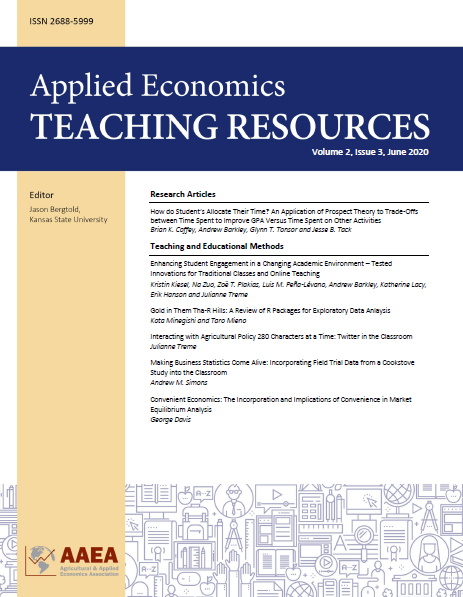Volume 2, Issue 3, June 2020
| View the entire issue |
 |
Research Articles
Brian K. Coffey, Andrew Barkley, Glynn T. Tonsor and Jesse B. Tack
Download PDF
Posted online: July 8, 2020
doi: 10.22004/ag.econ.303903
Abstract: We employ a choice experiment survey to elicit university students’ preferences for grade point average (GPA) relative to time spent on various activities. Using expected utility and prospect theory approaches to analyze those preferences, we find statistically significant asymmetry between the desire to increase GPA and the desire to avoid a decrease in GPA. Surveyed students were loss averse regarding GPA: they would trade approximately 4.6 times as much free time to avoid losing a point in their semester GPA relative to time they are willing to give up to gain one additional point. This study contributes to the growing research regarding prospect theory by analyzing loss aversion in a novel context of students’ time allocation.
Keywords: Teaching and learning, prospect theory, choice experiment, university students
Teaching and Educational Methods
Kristin Kiesel, Na Zuo, Zoë T. Plakias, Luis M. Peña-Lévano, Andrew Barkley, Katherine Lacy, Erik Hanson, and Julianne Treme
Download PDF
Posted online: June 24, 2020
doi: 10.22004/ag.econ.303904
Abstract: Agriculture is a global industry that constantly innovates and increasingly uses cutting-edge technology. A great number of job opportunities exist because this important sector of the economy is looking to recruit motivated and ambitious young people. Meanwhile, the academic environment is changing. Many programs experience increased class sizes and are introducing online curricula. Addressing these simultaneous challenges, eight teaching scholars from agricultural and applied economics programs presented their teaching approaches in a track session at the 2019 AAEA Annual Meeting. This article continues the conversation about specific teaching innovations tested in traditional classroom settings and online environments in an attempt to share lessons learned with a broader audience. Many of the insights presented here are easily adaptable when teaching remotely and will remain relevant once campuses reopen.
Keywords: Active learning, large classes, online tools, student engagement, teaching innovations, undergraduate teaching
Gold in Them Tha-R Hills: A Review of R Packages for Exploratory Data Analysis
Kota Minegishi and Taro Mieno
Download PDF
Posted online: June 25, 2020
Supplementary Materials
doi: 10.22004/ag.econ.303913
Abstract: With an accelerated pace of data accumulation in the economy, there is a growing need for data literacy and practical skills to make use of data in the workforce. Applied economics programs have an important role to play in training students in those areas. Teaching tools of data exploration and visualization, also known as exploratory data analysis (EDA), would be a timely addition to existing curriculums. It would also present a new opportunity to engage students through hands-on exercises using real-world data in ways that differ from exercises in statistics. In this article, we review recent developments in the EDA toolkit for statistical computing freeware R, focusing on the tidy verse package. Our contributions are three-fold; we present this new generation of tools with a focus on its syntax structure; our examples show how one can use public data of the U.S. Census of Agriculture for data exploration; and we highlight the practical value of EDA in handling data, uncovering insights, and communicating key aspects of the data.
Keywords: Exploratory data analysis, data science, data visualization, R programming
Interacting with Agricultural Policy 280 Characters at a Time: Twitter in the Classroom
Julianne Treme
Download PDF
Posted online: June 29, 2020
Supplementary Materials
doi: 10.22004/ag.econ.303917
Abstract: This article describes how Twitter can be used as a pedagogical tool to increase student engagement with agricultural policy both inside and outside of the classroom. This assignment, which can be tailored by instructors to meet learning objectives for a variety of course levels, can be used specifically to bridge the gap between economic graphs and real-world applications. In addition to increasing student familiarity with current events and real-world application of agricultural policy, the Twitter assignment requires students to operate on every level of Bloom’s taxonomy with a focus on students’ creativity and critical analysis skills.
Keywords: Social media, networks, pedagogy, education, Twitter, teaching of economics
Andrew M. Simons
Download PDF
Posted online: July 6, 2020
Teaching notes and Supplementary Material
doi: 10.22004/ag.econ.303918
Abstract: This paper describes how to incorporate data from a randomized controlled trial in rural Uganda into teaching an undergraduate business statistics course. The semester-length classroom exercise includes discussions and brainstorming sessions, which allow students to imagine how they would execute a field experiment and analyze the data. Students become familiar with one data set as they use it to supplement textbook examples of hypothesis testing, analysis of variance applications, and simple linear regression. The article discusses the background of the sustainability challenge of 2.8 billion people in the world cooking with solid fuels, the rollout and schedule of integrating field-experiment data into the classroom, and student evaluations of the exercise. The target audience is undergraduate statistics students and/or instructors interested in demonstrating how textbook statistics are used to better understand a real-world sustainability challenge.
Keywords: Classroom integration, climate change, health, poverty, randomized controlled trial, teaching statistics
George Davis
Download PDF
Posted online: July 8, 2020
Supplementary Power Point Presentation
doi: 10.22004/ag.econ.303919
Abstract: Convenience is perhaps the most important “commodity” being sold in the market today, and yet there is nothing of analytical substance to be found in most undergraduate textbooks. The purpose of this article is to provide a straightforward framework for teaching students the economics of convenience, utilizing the standard tools of introductory and intermediate microeconomics. The framework is used to answer several questions related to convenience that could not be answered with the typical supply and demand framework found in undergraduate textbooks. The key analytical features of the article are provided in a complementary PowerPoint file in the online supplementary appendix.
Keywords: Convenience, cost shifting, food, household production, scale economies, scope economies









